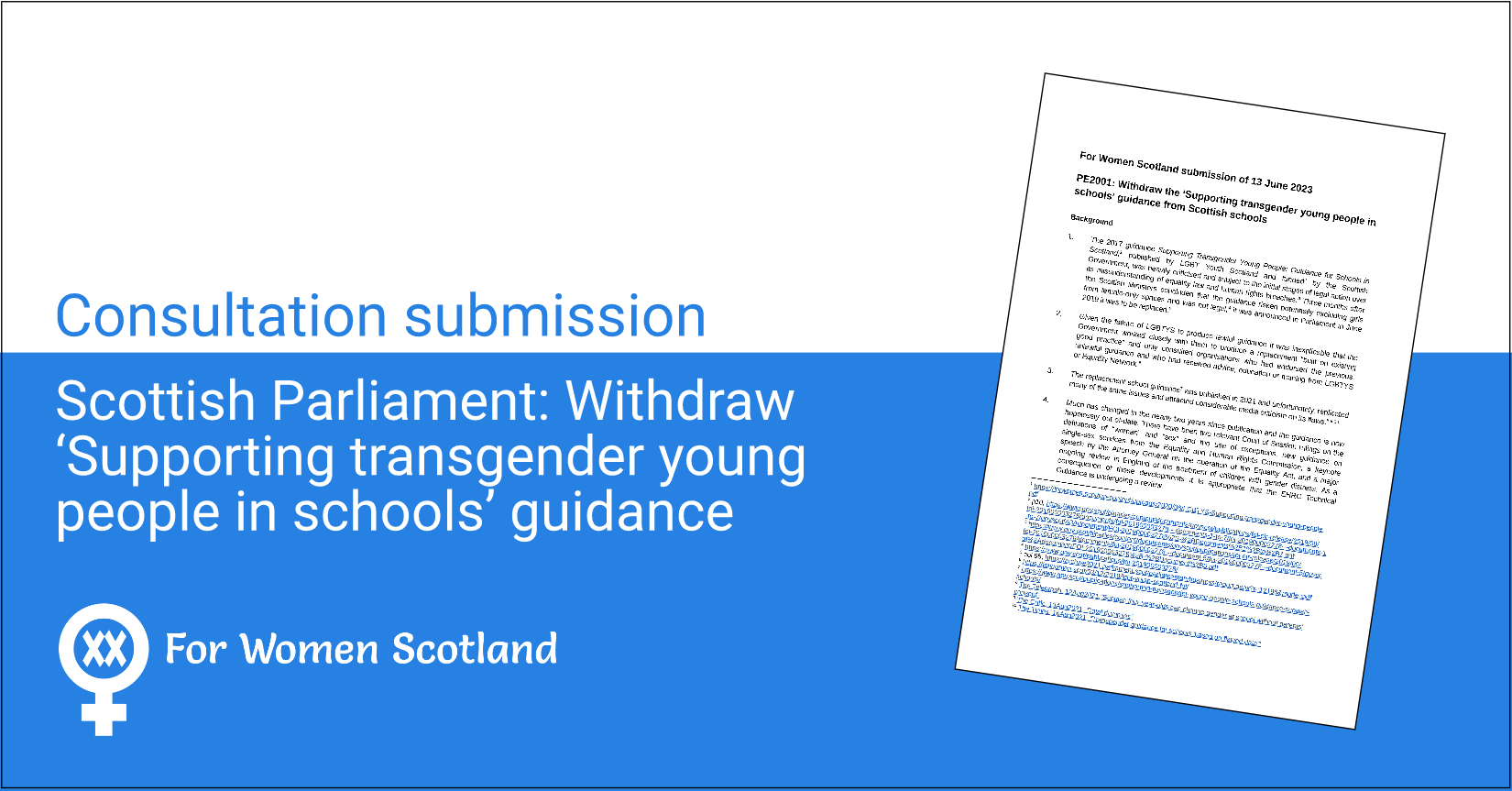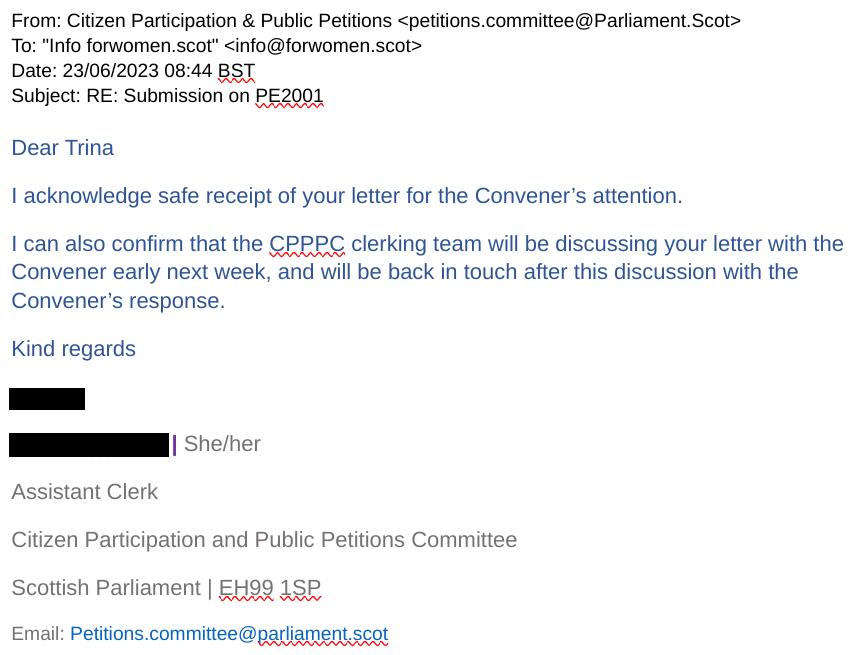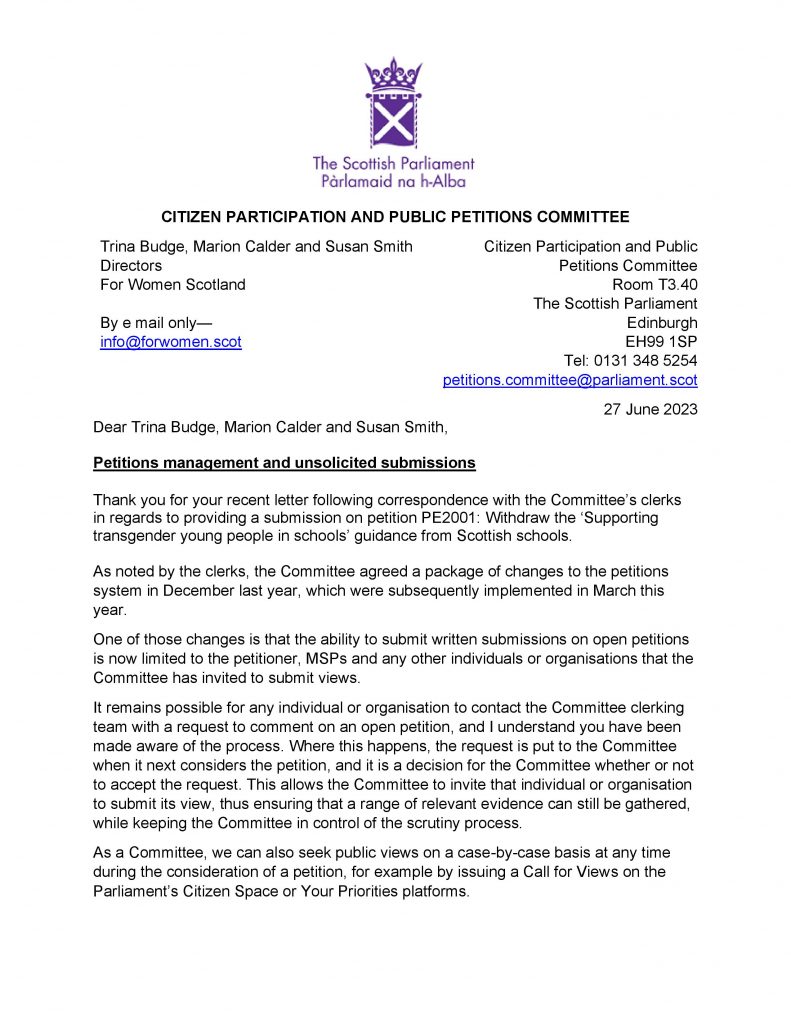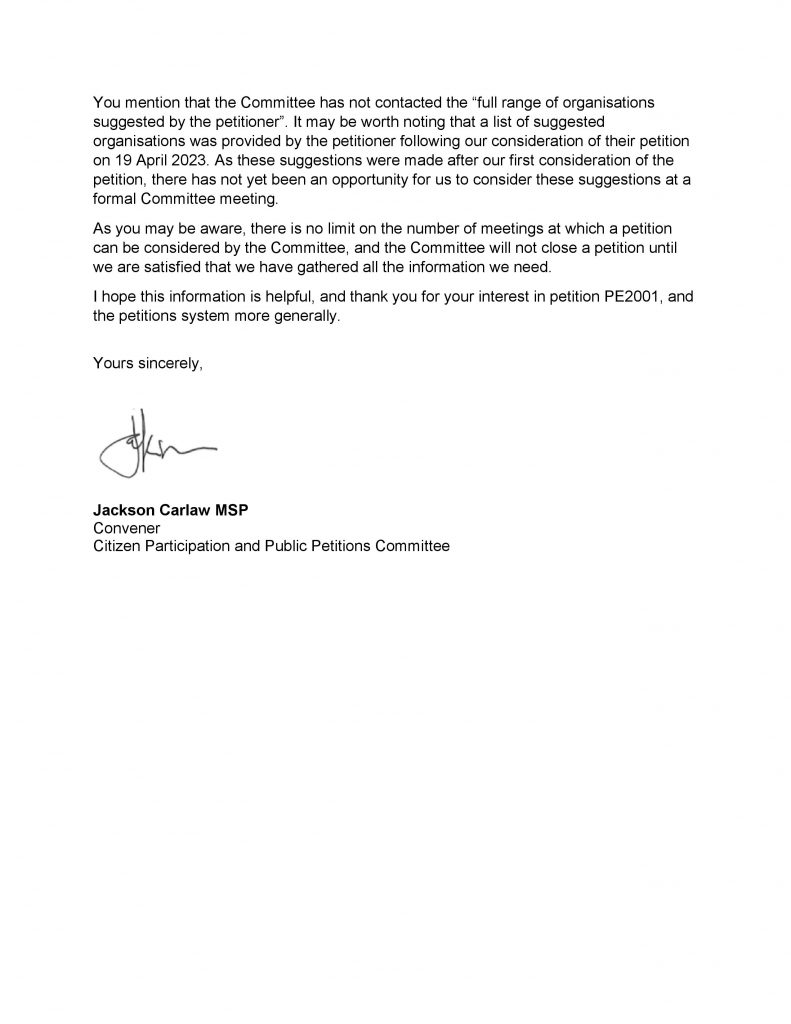Withdraw the ‘Supporting transgender young people in schools’ guidance from Scottish schools

This is our submission to the Citizen Participation and Public Petitions Committee who are considering petition PE2001 calling on the Scottish Parliament to urge the Scottish Government to withdraw the ‘Supporting transgender young people in schools: guidance for Scottish schools’ resource, and await the outcome of the Cass Review before developing a new resource. It’s also available to view/download as a PDF.
However, due to a rule change our submission may not be seen by Committee members as they now only accept information from groups they have sought out. In this case it means LGBT Youth Scotland and Equality Network, but not any alternative or opposing views. We have written to the Convener of the Committee with our concerns regarding this.
Background
- The 2017 guidance Supporting Transgender Young People: Guidance for Schools in Scotland, [1] published by LGBT Youth Scotland and funded [2] by the Scottish Government, was heavily criticised and subject to the initial stages of legal action over its misunderstanding of equality law and human rights breaches. [3] Three months after the Scottish Ministers concluded that the guidance risked potentially excluding girls from female-only spaces and was not legal, [4] it was announced in Parliament in June 2019 it was to be replaced. [5]
- Given the failure of LGBTYS to produce lawful guidance it was inexplicable that the Government worked closely with them to produce a replacement “built on existing good practice” and only consulted organisations who had endorsed the previous, unlawful guidance and who had received advice, education or training from LGBTYS or Equality Network. [6]
- The replacement school guidance [7] was published in 2021 and unfortunately, replicated many of the same issues and attracted considerable media criticism on its flaws. [8, 9, 10]
- Much has changed in the nearly two years since publication and the guidance is now hopelessly out-of-date. There have been two relevant Court of Session rulings on the definitions of “woman” and “sex” and the use of exceptions, new guidance on single-sex services from the Equality and Human Rights Commission, a keynote speech by the Attorney General on the operation of the Equality Act, and a major ongoing review in England of the treatment of children with gender distress. As a consequence of these developments it is appropriate that the EHRC Technical Guidance is undergoing a review.
Single-sex provision
- There are many areas of concern in the guidance but the following quotes serve as examples that are demonstrably unlawful and which negatively impact on the rights of girls in particular:
“There is no law in Scotland which states that only people assigned male at birth can use men’s toilets and changing rooms, or that only people assigned female can use women’s toilets and changing rooms.” (p26)
“It is therefore important that young people, where possible, are able to use the facilities they feel most comfortable with.” (p27)
“if PE classes are organised by sex, a transgender young person should be allowed to take part within the group which matches their gender identity. For a non- binary young person, ask them which group they would feel most comfortable being with” (p30)
“If a transgender young person wants to share a room with other young people who share their gender identity, they should be able to do so” (p32)
Toilets and the law
- Mixed-sex toilets are not legal in Scottish schools. The Building standards technical handbook 2019: non-domestic [11] provides guidance for accessible toilets and states that, otherwise, sanitary facilities in schools should be provided in accordance with the School Premises (General Requirements and Standards) (Scotland) Regulations 1967. This law gives a minimum number of appliances dependent on the school roll and mandates that half the accommodation shall be for boys and the other half for girls. [12] There is no provision for unisex, mixed-sex or gender-neutral facilities within that number.
- The school guidance omits any mention of this legal requirement. It is missing entirely, even in the “Policy, legislation and further information” section on p53.
- The EHRC recently published its own guidance Separate and single-sex service providers: a guide on the Equality Act sex and gender reassignment provisions, which clarifies that protecting girls’ privacy, dignity and safety are quite legitimate aims for providing single-sex spaces such as toilets and changing rooms in schools, and advises on the need to take into account other legislation (such as the School Premises Regulations). [13]
- The decision in our most recent judicial review (currently under appeal) stated that “sex” in the Equality Act is not limited to biological or birth sex, but includes those in possession of a Gender Recognition Certificate stating their acquired gender. [14] Children of school age are not eligible to apply for a GRC so any legal arguments about how GRCs are viewed for the purposes of the Equality Act are not applicable here. Pupils remain of their birth sex and should be treated as such under the Equality Act.
- Pupils may hold the protected characteristic of gender reassignment, but the right not to suffer discrimination on these grounds is not the same as a right of access to facilities provided to the opposite sex. Where separate-sex facilities have been provided, boys, regardless of how they identify, have no right of access to the girls’ facilities (and vice versa).
- The decision in our previous judicial review, at appeal to the Inner House, stated that where provision is made for women (defined in the Equality Act as females of any age) then, by definition it excludes biological males. [15] The Scottish Government has accepted this decision and the case is now settled law.
- In addition to these laws, a legal opinion by Aidan O’Neill KC concluded there is an enforceable requirement for local authorities to provide separate toilets for boys and girls under their legal obligation to prohibit harassment related to the pupils’ sex and which can be perceived by pupils as having the effect either of violating their dignity or of creating an intimidating, hostile, degrading, humiliating or offensive environment (Equality Act, schedule 3, s26 and s85(3)). [16, 17]
- There can be no comparable harassment claim related to gender reassignment as section 85(10) Equality Act states that this is not a relevant protected characteristic in the application of s26 on harassment in schools. [18] The school guidance is therefore incorrect when it claims on p57 that “The Act provides certain protections for those with a protected characteristic, this includes protections from discrimination, harassment and victimisation”.
- In August last year the Attorney General for England and Wales, spoke at length about the Equality Act and single-sex spaces, and affirmed the decision of our first judicial review when she re-stated that single-sex provisions operate on the basis of sex as a biological term. [19] She also said:
“In law, single sex services are intended for one sex only: that is the very thing permitted by Schedule 3. It follows that it is not possible to admit a biological male to a single-sex service for women without destroying its intrinsic nature as such: once there are XY chromosome adults using it, however they define themselves personally, it becomes mixed-sex.”
“Yes, it is lawful for a mixed school to refuse to allow a biologically and legally male child, who identifies as a trans-girl, from using the girls’ toilets. This does not constitute direct sex discrimination and is not unlawful indirect discrimination on grounds of gender reassignment. Indeed, if the school did allow a trans-girl to use the girl’s toilets this might be unlawful indirect discrimination against the female children. Further, in law, there is a duty to provide separate single sex toilets, a breach of which would be unlawful under the School premises regulations.”
- If a child does not feel comfortable – for whatever reason – in using the toilets provided for his/her sex, there is scope to make suitable alternative arrangements which do not infringe on the rights of others to single-sex provision. There is also no restriction on providing self-contained individual gender-neutral toilets in addition to the minimum number of separate-sex toilets, and it is surprising the school guidance does not suggest this as a solution.
Misrepresentation
- The rather lengthy explanation above demonstrates how woefully inadequate the school guidance is, with legislation misrepresented and not up-to-date with legal developments. Of course, both the organisations with most input, LGBTYS and Equality Network/Scottish Trans, are registered political lobbyists who have long campaigned to remove single-sex provision from the Equality Act. [20] It is by no means a stretch to consider they have presented the law as they wish it to be rather than how it actually is, in a similar manner to that of Stonewall at Essex University. [21]
- Even before the Equality Act was enacted in 2010 LGBTYS campaigned Parliament to have “gender identity” specified as a protected characteristic in the Act rather than gender reassignment. [22] The school guidance contains 61 mentions of gender identity when it is not a legal concept, most people do not have a gender identity, and nor do they believe in it. For guidance that is supposedly evidence based it is worrying to see it embedded as if fact and with no recognition of the protected belief in the reality and importance of sex. Not only does this inhibit accurate information on the law but it restricts the rights of both staff and pupils to speak freely and without punishment.
- The final two quotes from the school guidance given in paragraph 5 above, show how the correct legal term, gender reassignment, has quickly segued into the lobby group’s desired characteristic of gender identity. For similar reasons to that outlined for toilets above the information given on single-sex sports and overnight accommodation is inaccurate and unlawful. At a time when 43% of girls feel they were sporty as primary pupils but no longer see themselves that way as teenagers [23] it is almost inconceivable to have school guidance that deliberately diminishes their opportunities, confidence and safety by allowing boys to participate and excel in girls’ sport, as well as use their changing rooms.
- Equality Network/Scottish Trans intervened in our most recent judicial review in support of the Scottish Ministers position that acquiring a female GRC is the point when a man is recognised in law as a woman and is entitled to access women’s rights. Before this point a man remains legally male. Yet, this position is contrary to the self-identification advice in the school guidance and is typical of the misrepresentation of law to suit the purpose in hand. Despite the court finding in the Ministers’ favour Equality Network, only this week, are now advising MPs that “Legal change of sex has no impact on trans people’s participation in sport”. [24]
Cass Review
- The findings of the Cass Interim Report [25] were so troubling that it led to a decision to close down the children’s gender identity clinic at Tavistock, London as not being a safe or long term viable option for care. The comparable children’s clinic at Sandyford, Glasgow is in an arguably far worse situation with a fifteen fold increase in referrals in six years [26] and twice the expected number of children either receiving treatment or awaiting a first appointment compared to England and Wales, given the relative population size. [27] Clinicians tell of more and more children who have already socially transitioned at school prior to any medical assessment or diagnosis creating an almost undeniable continuation of affirmation with (experimental) medication and surgery. [28]
- There can be little doubt that the advice given in the guidance to schools has largely contributed to the rapid increase in referrals by encouraging teachers to affirm children who say they are trans and use their chosen pronouns such as ‘zie’ or ‘ey’ and to avoid misgendering, along with changing pupils names and sex on school records. Consultant psychiatrist Dr David Bell spoke on the Nolan podcast of the harm this social transitioning can do: adults are confirming there is something wrong with a child’s body and it locks the child into a medical pathway which can be difficult to retract from, forecloses options and inhibits any therapeutic treatment. [29]
- A freedom of information response shows that Sandyford recommends only watchful waiting for pre-pubertal children, [30] in contrast to the school guidance which, with no medical or child development expertise, irresponsibly advises affirmation for both primary and secondary aged children leading to staff socially transitioning children as young as four years old. We have heard numerous accounts of this being done without parents consent or even knowledge.
- Almost 60% of schools participate in LGBTYS’s Charter Award scheme which further influences school policy and emphasises the advice to socially transition children. [31] Freedom of information responses have revealed that one school received feedback from LGBTYS that “Best practice would be…not to out LGBT young people to their parents.” [32] This was deemed a mandatory requirement for the school policy to include and without it the school would not achieve their charter award. Preferred pronoun use is often compulsory with refusal treated as bullying and subject to disciplinary measures. [33] Schools also have to provide evidence of LGBT safe spaces within the school (changing rooms/gender-neutral toilets/gender-neutral PE classes). [34]
- NHS England published its Interim service specification for specialist gender incongruence services for children and young people on 9th June which contains more evidence based recommendations regarding social transitioning. [35] It remains cautious about this medical intervention with full exploration of other issues which may have caused gender distress and a strong therapeutic input. There is a move away from ideology and towards a proper clinical care model with risks and unknowns discussed with both child and family.
- The Chief Executive of Greater Glasgow and Clyde NHS has welcomed the Cass Review and stated “We view this as both timely and wholly relevant to informing the development of the future service model in Scotland.” [36]
- With the full Cass report not expected before the end of the year it is clear this is an area in flux and best evidence treatment and protocols are yet to be finalised. However, clinicians in Scotland are ethically bound to provide the highest level of care and the mismatch between Sandyford and the new service in England cannot continue. Teachers and other school staff are simply not medically qualified to be affirming a child’s self-diagnosis of gender dysphoria and socially transitioning. The advice in the school guidance is wholly inappropriate and must halt until Dr Cass publishes the full review results. The Committee should use this opportunity to assess the damage already done to children and families across the country and rid our schools of the influence of lobbyists and their unscientific, unevidenced ideology.
References
- https://forwomen.scot/wp-content/uploads/2020/06/LGBTYS-Supporting-transgender-young-people.pdf
- p10, https://www.gov.scot/binaries/content/documents/govscot/publications/foi-eir-release/2019/09/foi-201900003278/documents/foi-201900003278—documents-1-to-7/foi-201900003278—documents-1-to-7/govscot%3Adocument/FOI-201900003278%2B-%2BDocuments%2B1%2Bto%2B7.pdf
- https://www.gov.scot/binaries/content/documents/govscot/publications/foi-eir-release/2019/09/foi-201900003278/documents/foi-201900003278—document-5/foi-201900003278—document-5/govscot%3Adocument/FOI-201900003278%2B-%2BDocument%2B5.pdf
- https://www.gov.scot/publications/foi-201900003278/
- col 95, https://archive2021.parliament.scot/parliamentarybusiness/report.aspx?r=12196&mode=pdf
- https://forwomen.scot/03/12/2019/lgbt-youth-scotland-foi/
- https://www.gov.scot/publications/supporting-transgender-young-people-schools-guidance-scottish-schools/
- The Telegraph, 12Aug2021,“Scottish four-year-olds can change gender at school without parents’ consent”
- The Critic, 13Aug2021, “Total dummies”
- The Times, 16Aug2021, “Transgender guidance for schools ‘based on flawed data’”
- https://www.gov.scot/publications/building-standards-technical-handbook-2019-non-domestic/3-environment/3-12-sanitary-facilities/
- https://www.legislation.gov.uk/uksi/1967/1199/pdfs/uksi_19671199_en.pdf
- https://www.equalityhumanrights.com/en/advice-and-guidance/separate-and-single-sex-service-providers-guide-equality-act-sex-and-gender
- Para 53, https://www.scotcourts.gov.uk/docs/default-source/cos-general-docs/pdf-docs-for-opinions/2022csoh90.pdf
- https://www.scotcourts.gov.uk/docs/default-source/cos-general-docs/pdf-docs-for-opinions/2022csih4.pdf
- https://forwomen.scot/12/06/2022/schools-must-provide-single-sex-toilets/
- https://www.legislation.gov.uk/ukpga/2010/15/schedule/3/part/7, https://www.legislation.gov.uk/ukpga/2010/15/section/85
- https://www.legislation.gov.uk/ukpga/2010/15/section/85
- https://www.gov.uk/government/speeches/equalities-and-rights-conflict-and-the-need-for-clarity
- https://womansplaceuk.org/2018/06/25/references-to-removal-of-single-sex-exemptions/
- https://sex-matters.org/posts/freedom-of-speech/the-reindorf-review-a-wake-up-call-for-universities/
- p12, https://webarchive.nationalarchives.gov.uk/ukgwa/20100210211352mp_/http://www.equalities.gov.uk/nosearch/pdf/LGBT%20Youth%20Scotland.pdf
- https://www.theguardian.com/education/2022/mar/07/uk-girls-lose-interest-in-sport-as-teenagers-women-in-sport-survey
- https://forwomen.scot/wp-content/uploads/2023/06/Westminster-Hall-Debate-June-12th-Equality-Act-2010-definition-of-sex-Scottish-Trans-and-Equality-Network-briefing.pdf
- https://cass.independent-review.uk/publications/interim-report/
- FOI showing 37 referrals in 2013:
https://forwomen.scot/wp-content/uploads/2019/12/Sandyford-FoI-response-27Sep19.pdf
NGICNS document showing 559 referrals in 2019 (para12, page 27): https://forwomen.scot/wp-content/uploads/2021/11/Gender-Service-Mapping-report-v1-1.pdf - FOI showing 1,253 at Sandyford: https://forwomen.scot/wp-content/uploads/2022/04/Sandyford_response_22Apr2022_anon.pdf
plus 1-4 17 year olds on adult waiting list in Inverness: https://forwomen.scot/wp-content/uploads/2022/04/Inverness-Gender-Clinic-response-18Apr2022.png
7,100 in England, The Times, 22Apr2022, “Sajid Javid inquiry into gender treatment for children” - https://www.youtube.com/watch?v=J9ZNINhdhN0
- https://fairplayforwomen.com/stonewall-transcripts/
- https://forwomen.scot/wp-content/uploads/2021/11/Sandyford-Third-sector-agency-referrals.pdf
- Scottish Daily Express, 25Apr2023, “Backlash after 60% of schools sign up to controversial LGBT charity scheme”
- https://forwomen.scot/wp-content/uploads/2023/04/2021_ELF891R-Musselburgh-Grammar-LGBT-Charter-Feedback-Form.pdf
- p437, https://forwomen.scot/wp-content/uploads/2023/04/1.-FCIR-34251-Part-1-Combined-File.pdf
- Para 5.5, https://forwomen.scot/wp-content/uploads/2023/04/3.-FCIR-34251-LGBTYS-Gold-Submission.pdf
- https://www.england.nhs.uk/publication/interim-service-specification-for-specialist-gender-incongruence-services-for-children-and-young-people/
- https://forwomen.scot/wp-content/uploads/2022/10/Letter-to-FWS-from-CE-NHSGGC.pdf
Update 23 June 2023:
We received the following email to say that the clerking team will discuss our letter with the Committee Convener.

Update 27 June 2023:
We received this letter from the Committee Convener:


Update 09 December 2023:
We heard nothing further but our letter was never published on the Committee’s web page for written submissions. The petition was closed down by the Committee on the 6th December without considering our evidence, or evidence from any organisation suggested by the petitioner.
